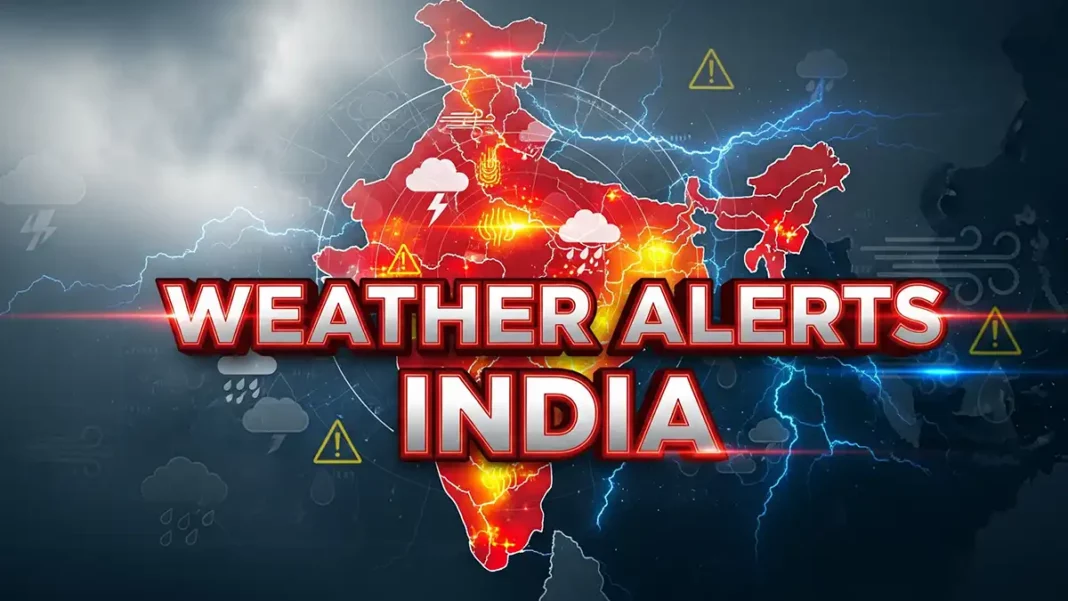Weather alerts india are becoming increasingly critical for public safety, yet many citizens remain unaware of the immediate dangers and necessary precautions. Are you prepared for the sudden shifts in weather that can disrupt daily life and pose serious threats?
In this article, you will learn about the latest weather advisories impacting major Indian cities, understand how to interpret IMD alerts today and discover essential safety measures during heavy rain alerts india, ensuring you stay safe and informed.
The Monsoon’s Grip: India Under the Weather Lens
India’s monsoon season, a lifeline for agriculture, often brings with it intense weather phenomena that necessitate heightened vigilance. From torrential downpours to gusty winds and potential flooding, the unpredictable nature of monsoon weather in various regions demands a proactive approach from both authorities and citizens.
Unpredictable Patterns and Their Impact
The monsoon, while vital, is inherently erratic. One day can bring pleasant showers, while the next might unleash a deluge. This unpredictability means that residents in major cities across India must remain acutely aware of local weather conditions.
The immediate impact can range from traffic chaos and power outages to more severe consequences like urban flooding and infrastructure damage. Understanding these patterns is the first step in preparing for sudden changes.
The Crucial Role of Early Warnings
In such a dynamic meteorological environment, timely and accurate early warnings are indispensable. These advisories, often issued by the India Meteorological Department (IMD), provide crucial lead time for individuals and authorities to prepare.
Ignoring these warnings can lead to significant disruptions and, in worst-case scenarios, pose grave risks to life and property. Recognizing the importance of these alerts empowers communities to take necessary protective actions.
Decoding IMD Alerts: What They Mean for You
The India Meteorological Department (IMD) employs a color-coded system to communicate the severity of weather conditions. Understanding this system is paramount for effective preparedness, especially when IMD alerts today are issued for your city.
Recent Alerts Across Key Metros
As of early July 2025, several major Indian cities are experiencing varying levels of alerts due to active monsoon conditions. Mumbai and surrounding Konkan regions, along with parts of Maharashtra’s ghat areas, have received heavy rain alerts india, with some areas even under Orange and Red warnings for isolated extremely heavy rainfall.
Similarly, parts of Himachal Pradesh and Uttarakhand are under Orange alerts due to heavy to very heavy rainfall and the potential for flash floods and landslides. Southern states like Kerala and Karnataka are also bracing for intense showers.
Meanwhile, Delhi is expecting moderate rain and thunderstorms, though without severe warnings as of now. Residents in these regions are advised to closely monitor local bulletins.
Beyond Rainfall: Other Crucial Warnings
While heavy rain alerts india are common during monsoon, the IMD also issues warnings for other significant weather phenomena. This includes alerts for strong winds, thunderstorms, lightning and even specific forecasts for squally weather along coastal regions affecting fishermen. In other seasons, advisories for heatwaves, cold waves and fog are equally critical. Each type of alert carries specific recommendations for safety, underscoring the comprehensive nature of weather alerts india. Staying informed about all potential hazards is crucial for holistic safety.
City-Specific Challenges and Preparedness
Each major Indian city faces unique weather challenges and, consequently, requires tailored preparedness strategies during periods of adverse weather. Understanding these specifics can make a significant difference in how effectively communities respond.
Mumbai’s Monsoon Resilience
Mumbai, a bustling metropolis, is particularly susceptible to urban flooding during the monsoon, even with moderate to heavy rain alerts india. Its low-lying areas and overwhelmed drainage systems make waterlogging a persistent issue. Authorities frequently issue advisories on high tides, commuter disruptions and safe travel routes. Residents are often urged to avoid waterlogged areas, stay updated on local train services and keep emergency kits ready. The city’s resilience is tested annually, requiring constant vigilance from its citizens to navigate the heavy downpours safely.
Delhi’s Dust Storms and Rainfall Variability
Delhi’s weather patterns present a different set of challenges. While it experiences monsoon rainfall, it is also prone to dust storms and sudden, intense thunderstorms during the pre-monsoon and monsoon transitional phases. These can severely impact air quality and visibility, leading to traffic hazards and health concerns.
The city’s relatively newer drainage infrastructure can sometimes struggle with intense, short bursts of rain, causing localized waterlogging. IMD alerts today for Delhi often focus on thunderstorm activity and associated risks.
Southern India: Coastal Rains and Landslides
Coastal cities in the South, like Chennai, Kochi and Bengaluru (though not coastal, affected by Karnataka’s rains), experience distinct monsoon influences. While Chennai often grapples with torrential rains leading to floods, regions in Kerala and Karnataka, especially in the
Western Ghats face risks of landslides due to continuous heavy rainfall over hilly terrains. Heavy rain alerts in India in these areas often come with warnings for slope stability and localized flooding, necessitating quick evacuations in vulnerable zones. Awareness of geological risks is paramount for residents.
Essential Safety Measures During Weather Alerts
Responding effectively to weather alerts india is crucial for minimizing risks. Proactive measures, both individual and community-wide, can significantly enhance safety and reduce potential damage.
Personal and Household Preparedness
When a weather alert is issued, immediate steps include securing loose outdoor objects, checking and clearing drains around your home and having an emergency kit ready. This kit should contain essential items like a flashlight, power bank, first-aid supplies, non-perishable food and drinking water.
Keep important documents in waterproof bags. It’s also wise to fully charge mobile phones and other devices before anticipated power outages. These simple steps can make a big difference when facing adverse conditions.
Navigating Commute Challenges
During heavy rain alerts india, commuting becomes particularly hazardous. Public transport might be delayed or suspended and roads can become waterlogged or damaged. It is advisable to avoid unnecessary travel. If travel is unavoidable, use reliable navigation apps for real-time updates on traffic and road closures.
Driving slowly, maintaining safe distances and avoiding flooded underpasses are critical. For two-wheelers, extra caution is paramount and it’s best to pull over if visibility is severely reduced.
Community and Digital Vigilance
Beyond individual actions, community-level preparedness is vital. Stay connected with local authorities and community groups for real-time updates and emergency instructions. Follow official sources like the IMD website and their social media channels for the most accurate IMD alerts today.
Avoid spreading unverified information, as misinformation can cause unnecessary panic. Participate in local disaster preparedness drills if available. A vigilant community is a resilient one, capable of responding collectively to challenges.
Looking Ahead: Adapting to Climate Shifts
The increasing frequency and intensity of extreme weather events underscore the need for continuous adaptation and improvement in how we handle weather alerts india. Climate change is influencing monsoon patterns, making preparedness an ongoing challenge.
Strengthening Urban Infrastructure
Many Indian cities are racing to upgrade their drainage systems, improve urban planning and build more resilient infrastructure to withstand extreme weather. Investments in smart city technologies, better waste management to prevent drain clogging and early warning systems are key.
These long-term projects are vital for protecting urban populations from future climate impacts, reducing vulnerability during heavy rain alerts india. Urban planners are constantly integrating climate resilience into development plans.
Enhancing Public Awareness and Education
While alerts are issued, the effectiveness hinges on public awareness and understanding. Continuous education campaigns on weather safety, interpreting IMD warnings and individual preparedness are crucial.
Workshops, public service announcements and easily accessible information through various media can empower citizens to make informed decisions. A well-informed populace is the strongest line of defense against severe weather.
The Future of Forecasting and Preparedness
The future of weather preparedness in India lies in integrating AI and machine learning into forecasting models for even greater accuracy, localized predictions, and quicker dissemination of IMD alerts today.
Developing community-based early warning networks and leveraging IoT devices for real-time environmental monitoring can further enhance resilience. The goal is to move towards a more predictive and adaptive system, ensuring that every citizen is not just aware but also fully prepared.
Conclusion
Staying informed about weather alerts india is no longer a mere convenience but a critical aspect of public safety and personal well-being. With monsoon season often bringing unpredictable and intense conditions, understanding IMD alerts today and knowing how to respond to heavy rain alerts india can significantly reduce risks.
From strengthening urban infrastructure to enhancing public awareness and leveraging advanced forecasting technologies, a multi-faceted approach is essential for building resilient communities. By taking proactive steps and remaining vigilant, we can collectively navigate the challenges posed by extreme weather and protect ourselves and our loved ones.
Frequently Asked Questions (FAQs)
What are the different color codes for weather alerts india issued by IMD?
The IMD uses Green (All is well), Yellow (Be Aware), Orange (Be Prepared) and Red (Take Action) to indicate alert levels.
How often are IMD alerts today updated during severe weather?
During severe weather, IMD alerts can be updated every few hours or even more frequently for rapidly changing conditions. It’s crucial to follow official IMD channels for real-time updates.
What specific precautions should be taken during heavy rain alerts india in urban areas?
During heavy rain alerts, avoid waterlogged areas, secure outdoor objects, keep emergency kits ready, charge mobile phones and avoid unnecessary travel.
Are there specific concerns for coastal cities during monsoon alerts?
Yes, coastal cities face risks from squally winds, high tides and potential urban flooding due to heavy rainfall. Fishermen receive specific warnings to avoid venturing into the sea.
Besides rain, what other types of weather alerts india does IMD issue?
IMD issues alerts for thunderstorms, lightning, strong winds, heat waves, cold waves, fog and sometimes cyclones, depending on the season and region.
Also Read:
David William comes from an Engineering background, with a specialization in Information Technology. He has a keen interest and expertise in Web Development, Data Analytics, and Research. He trusts in the process of growth through knowledge and hard work.


